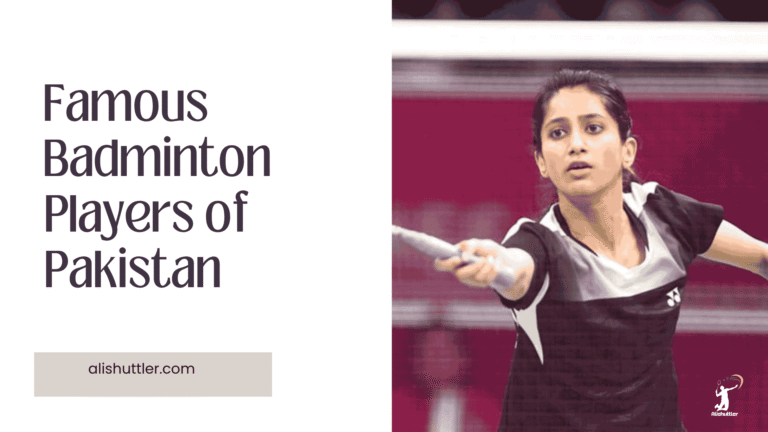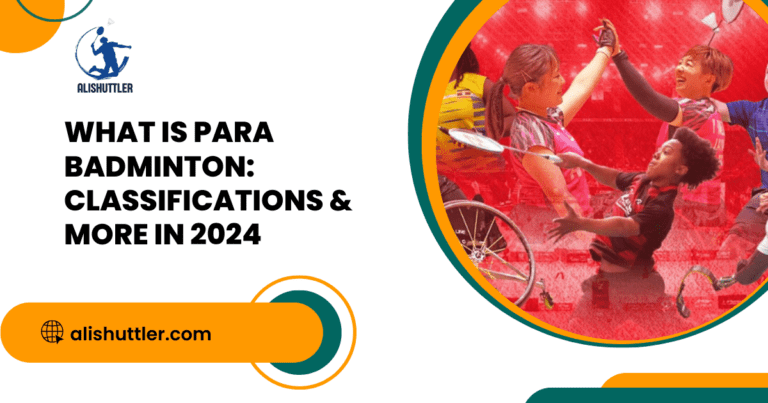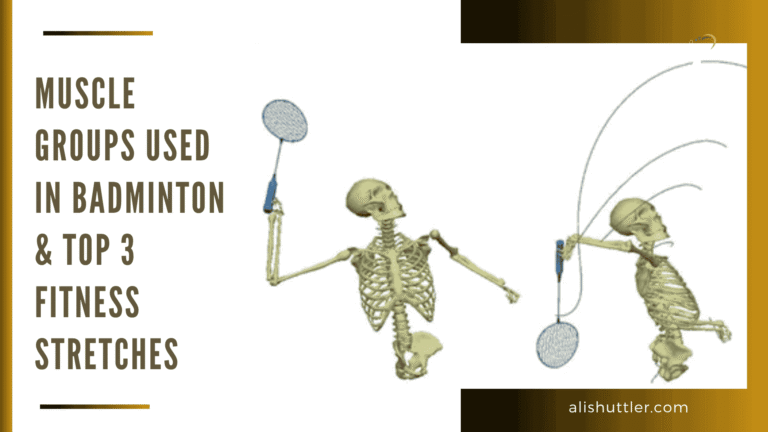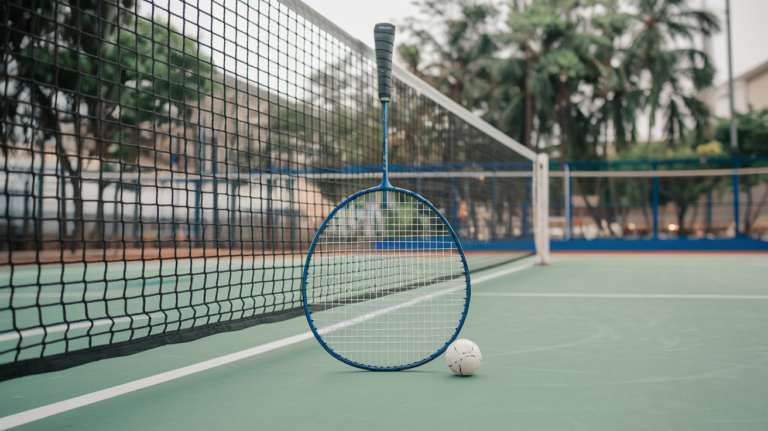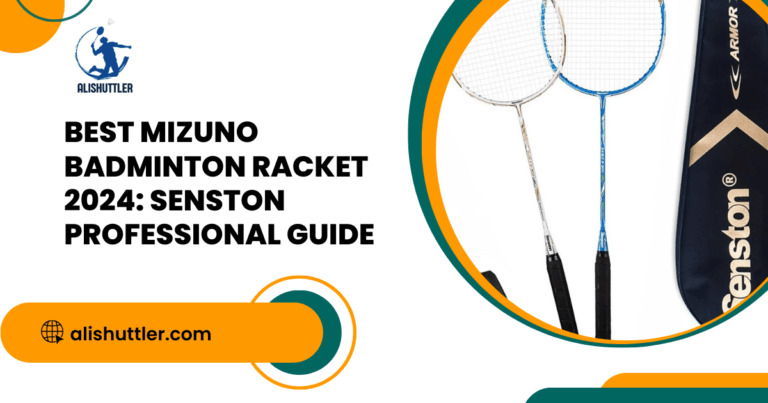Which badminton racket is best for smashing? For example, the best badminton racket for smash usually features a head-heavy balance, stiff shaft, and strong frame to assist with power generation.
Rackets like the Yonex Astrox 99, Li-Ning Turbo Charging 75, and Victor Thruster K series score high in their smash power.
Most players select these frames for fast swings and firm control.
To help you choose the one for your style and level, the next sections explain the key characteristics.
The Ultimate Smash Racket
Smash badminton rackets share common features, such as a balance point that distributes weight into the head for devastating smashes and a shaft that strikes a balance between flexibility and stiffness. The choice of the ultimate performance badminton racket is highly personal, influenced by player technique, aggressive playing style, and comfort.
1. Balance Point
A head-heavy racket puts additional weight toward the top, driving additional power into every smash. This design assists players in delivering added power with no additional effort. With more weight at the head, getting into position for quick net shots can feel sluggish, particularly in rapid rallies.
By contrast, head-light rackets put the weight towards the handle. These rackets swing faster, are very controllable and reward players who use speed and wrist action. For smashing however, head heavy options such as the Yonex Astrox 88D or Victor Thruster K Falcon shine for offensive batsmanship. Both provide conveniently located balance points that allow players to swing with force without sacrificing control for strategic shots.
2. Overall Weight
Most power smashers like a 3U racket (~85–89g). This weight class provides a great balance of punch for smashes and speed for defense. Heavier rackets can increase smash velocity but reduce arm speed, making rapid exchanges more difficult to manage.
Light rackets (4U and under) aid in reflexes but can be shallow in smashes if your swing is weak. Selecting weight correctly means considering your individual power. A heavier frame is best for those who like to attack, while a lighter one assists defensive or all-round players get around with ease.
3. Shaft Stiffness
Medium to stiff shaft makes energy transfer more direct, giving each smash extra bite and making shots more precise. This shaft type assists seasoned players put the shuttle with precision by minimizing excess flex during a swing.
For newcomers, a flexible shaft can camouflage errors, assisting players who have not perfected style yet. Hard hitting and well-timed players get the most out of stiff rackets. Beginners tend to find flexible shafts more forgiving, but sacrifice some pure power.
4. Frame Shape
Frame shape affects how a racket slices through air and how simple it is to locate the sweet spot. An isometric (boxy) head shape provides a larger sweet spot, forgiving off-center blasts—a bonus for novices.
Aero frames — like the Yonex Nanoflare’s — swing faster, allowing players to seize the moment and whip the racket through the air for rapid smashes. Testing various shapes is essential. Some will suit your grip and swing more than others.
5. String Tension
Higher tension, normally around 26–28 lbs, can make a smash crisper — only if you’re able to wield it with power and precision. High tension is more control but a smaller sweet spot, so your hits have to be accurate.
Great strings matter as well–strong, lively strings can enhance both power and touch. Select a tension that fits your ability and feel.
Why Head-Heavy Dominates

There’s a reason head-heavy badminton rackets keep appearing in power-oriented games. They bias more mass into the upper half of the frame, and this mass shift transforms the feel of every shot. For badminton enthusiasts who desire to crack hard, this balance assists in providing genuine increases in power and shot velocity.
The fundamental advantage of heavy smashing rackets is how they leverage swing power and momentum. When a player swings, the added heft in the head imparts more force on the bird post-impact. This translates to less work packing more punch — critical for devastating smashes. If two players swing equally fast, the player with a head-heavy racket will hit harder than the player with a head-light racket.
Momentum is a huge reason why these rackets function so brilliantly. When you swing, that extra weight at the top keeps the racket in motion, so the energy goes directly into the bird. This is especially evident when fast smashes must be rapid but there’s not enough time to wind up.
While lighter rackets can move fast, they don’t have the follow-through power that makes a smash so hard to return. If a player can manage the additional weight, they receive a great balance of quickness and force. It’s this trade-off that’s why aggressive players, who already possess solid technique, frequently opt for head-heavy rackets for offense.
Weight distribution influences racket feel. A head-heavy racket with a flexible shaft and medium string tension facilitates loading up power without fatiguing the arm. These configurations are useful for players who seek hard smashes, but don’t necessarily possess elite strength.
The slight slowness of the added weight can be a benefit as well. It allows players to sense the racket’s trajectory, which aids in timing and positioning. The consequence is crisper, more precise smashes — not raw power.
Most expert and professional badminton players choose head-heavy rackets due to these advantages. They frequently report improved power, more consistent follow-through, and increased confidence on big shots.
Some well-known examples of top-performing head-heavy rackets for smashing can be seen in the table below:
| Brand/Model | Weight (grams) | Balance Point (mm) | Shaft Flexibility | Known For |
|---|---|---|---|---|
| Yonex Astrox 99 Pro | 85 | 305 | Stiff | Power & Control |
| Victor Thruster K Falcon | 87 | 304 | Medium-Stiff | Explosive Smashes |
| Li-Ning Turbo Charging 75 | 83 | 306 | Medium | Speed & Power Balance |
| Yonex Voltric Z-Force II | 88 | 310 | Extra Stiff | Extreme Power |
Beyond The Racket Head

Smash power isn’t solely dependent on the badminton racket; it also hinges on a player’s movement, grip, and consistent practice. The ultimate performance badminton racket must enhance your technique and playing style, allowing aggressive players to execute devastating smashes with unparalleled power.
Shaft Technology
New shaft designs are revolutionizing smash landings. With things like graphite, shafts become more rigid and screen out strident vibrations. What this translates to is that when a player swings, more of their energy goes directly into the shuttle, not dissipated in the frame.
A few rackets employ tapered shafts to accelerate the snap-back, thus increasing the velocity of each smash. A handful of brands such as Yonex, Victor and Li-Ning take the lead with high-end shaft choices. Graphite blends are standard, and some mix in nano-resin or specialty fibers to increase stiffness.
For instance, rackets like Yonex Astrox 99 Pro or Victor Thruster F have high-modulus graphite shafts. These not only amplify power but assist with control on every stroke.
| Model | Shaft Material | Key Feature |
|---|---|---|
| Yonex Astrox 99 Pro | High-modulus graphite | Extra stiff, power focus |
| Victor Thruster F | Graphite + PYROFIL | Fast snap, less shake |
| Li-Ning 3D Calibar 900 | Carbon fiber blend | Energy return, solid feel |
Grip Size
The correct grip size prevents the racket from twisting out. It keeps the wrist relaxed for a clean smash. Too small, and you hang on too tight, courting wrist agony. Too big, and you lose fast wrist flicks.
It helps with control and keeps your smashes on target. Not only does the right grip size lead to better performance, it means less injuries. If your hand fills the handle, your shots employ less muscle.
This reduces stress on your wrist and elbow. A lot of players experiment with grip sizes with overgrips to get that good feeling. It’s a small step to better smashes and more comfort.
Material Composition
A racket’s composition is crucial for both smash strength and durability. Carbon fiber, for instance, is strong but light, so swift swings come easy. Some rackets employ blends with resin for stiffer frames, which transmit more energy to the shuttle.
Premium stuff counts most for hard smasher players. If the frame is weak, it could warp. Rackets like Yonex Voltric Z-Force II or Li-Ning Turbo Charging 75 are engineered with tough carbon bodies.
These rackets KNOW you’re going to lace ’em and they can take hard hits and still feel crisp swing after swing.
Player Factors
Smash speed is generated by a player’s movement and swing. Good form allows the body to contribute power, not just the arm. Practice develops the timing required for a powerful smash.
Some opt for a head-heavy racket to give extra force to each stroke, while others crave a lighter frame to dart around in doubles. A player’s power, consistency, and strategy all count.
Experimenting with different weights–3U for power or 4U for speed, for example–allows each player to discover their sweet spot.
Finding Your Smash Partner

How to find your smash partner? Skill, style, and needs all factor in, especially for badminton enthusiasts looking to improve their game. It needs to be right for where you are in your game and where you want to go. Finding your smash partner—yeah, the one to hone your skills against—is equally important. The right partner hones your skills, keeps you inspired, and teaches you both attack and defense, helping you develop a powerful shot placement. For every player, communication and consistency are the keys to growth.
Beginner
Beginners require rackets that are light and easy to swing. Lightweight frame translates into less wrist and shoulder tension, which makes it easier to learn form and timing. Forgiving rackets—those with oversized heads and flexible shafts—aid in off-center strikes, which abound during this phase.
Control means more than power when you’re getting started. A balanced racket, with its weight evenly distributed, provides beginners stable strokes and improved control. One of these rackets aids in mastering footwork, shot placement, and elementary smash shots without feeling overwhelming.
For instance, Yonex Nanoray 10F or Li-Ning Windstorm 72 are known for their easy handling and softness. They allow you to concentrate on your fundamentals, yet still have fun.
Intermediate
Intermediate players require a racket that can keep pace with a more expansive skill set. At this level, smashing power is more important, but so is control. Rackets with a medium flex shaft and a balance point closer to the head provide an excellent combination of power and maneuverability.
Versatility is important if you’re still defining your style of play. Some may be inclined to offense, some on defense, so experimenting with different weights and grips can assist. It’s smart to try rackets with different specs—such as the Victor Brave Sword 12 or Yonex Astrox 7.
These choices provide both punch for smashes and sufficient feedback for net play, assisting you in finding what comes most naturally. Practice with partners who bring different strengths to the court–one with a fast smash, another with rock-solid defense–to round out your game.
A little good communication goes a long way in helping you both get better, exchanging tips and tweaking strategies as a team.
Advanced
High-level competitors frequently opt for speed and maximum smash power-oriented rackets. Advanced models employ stiff shafts and head-heavy balance, which allow expert hands to transform a brief swing into a piercing, blistering smash.
High-end rackets such as the Yonex Astrox 99 Pro or Victor Thruster F are popular options for their aggressive frames and innovative technology. The customization is what counts at this point.
Advanced players might adjust grip size, string tension or even the racket’s weight to accommodate their own preferences. A consistent smash partner, someone that can strike with precision and strain your defense, is key.
This assists you in honing your technique and strategy, while keeping you match sharp. Partners can push each other, swap feedback, and develop confidence through regular sessions.
Tips for Every Level
- Test several rackets before you buy—feel and fit matter.
- Choose a smash partner with similar goals and schedule.
- Seek out rackets that suit your level, not your price range.
- Discuss frequently with your partner to address weak points.
The Control Paradox
Selecting a badminton racket for smashes is not simply about selecting the one with the highest power. The control paradox is that trying for more control can, ironically, lead to less true control — or even cause smashes to be less precise. This paradox is evident in the trade-off between power and precision.
Some players desiring rackets offering more control can find themselves less precise, particularly if the racket does not suit their technique or style. For others, control rackets require perfect technique, which can be hard for less talented or less trained players. How a racket feels in hand—its weight and balance—also informs a player’s perception of control.
Discovering which works best is personal, and every dueling player has to balance the power/control trade-offs with their own strengths.
- Control is everything if you’re going to place smashes deep or sharp on court.
- Just like such precise smashes require rackets that suit your timing and swing.
- A racket with too much power can make it difficult to direct.
- Accuracy crushes score, but only with a racquet you can control.
- Every player’s best control comes from comfort and practice.
Power vs Precision
Smash hard and you’re very often sacrificing precision. The harder a player swings with his heavy racket the faster the shuttle speed, but the more probable the miss. A few rackets designed for power muffle the feedback a player senses, making it more difficult to position the shuttle perfectly.
This is the reason why certain players can’t hit smashes in the lines with a power racket. To play well, you must have power and precision. A powerful smash can secure rapid points, but if it’s misdirected, it provides the opposition with effortless smashbacks.
So proficient players practice both the power of their stroke and the capability to direct the shuttle where they desire. That is, not just whacking hard, but learning to control direction and depth.
It’s practice that’s the only way to master this balance. By repeatedly smashes with different rackets, you find out which one supplements your style. Concentration exercises, hitting a target, and game play all develop both strength and precision.
Tips: Start with mid-weight rackets. Just practice smashes–at half power for accuracy. Gradually increase the speed as your control enhances. Switch rackets to find what fits your hand and swing.
The Trade-Off
Heavy rackets generate more power, thus speeding up and strengthening smashes. They can be sluggish to respond, which damages control, particularly at the net. Lighter rackets are simpler to swing and can help you respond faster, they might not provide you the smash speed you desire.
That’s where the control paradox rears its head–more power can equal less control. Both players have different strengths. Some have fast wrists, some mighty arms. Knowing your game is the secret.
If you’re speedy and love jab rallies, a lighter racket may be right for you. If you depend on big smashes, a heavier model could assist, but only if you can manage the weight. Experimenting with different rackets is the surest way to discover your equilibrium.
See if you can borrow from friends or test at a shop. Pay attention to what each one feels like on smashes and blocks.
Prioritizing Individual Needs
No one racket suits all. What matters most is your skill level, playing style and comfort. Control rackets can be brutal for neophytes, but they honor finesse.
Think about your main goals: power, control, or a mix. Experiment, experiment, experiment — and experiment some more.
Debunking Smash Myths

Most players seek the best racket for smashes but there are some common myths that can misguide buyers. When choosing a racket, it’s tempting to get caught up in equipment, but it’s equally crucial to understand what actually counts for a killer smash.
A myth that heavier rackets pound harder. Although a heavier racket can impart momentum, it will bog down your swing or diminish your control if it doesn’t match your style. Others lighter rackets, typically described as less powerful, are used by elite players for blistering, incisive smashes.
Balance on top of that, too. Although most people will say a ‘head heavy’ racket is the best for smashers, certain ‘head light’ rackets have demonstrated the opposite. For instance, a head-light racket once held the Guinness World record for fastest smash — proving that weight and balance partnered with technique and not in isolation.
Another popular notion is that higher string tension increases smash power. A lot of beginner string their rackets heavier than 12 kg (26 lbs), believing it will make them hit harder. The reality is that higher tension can provide more control but not necessarily additional power.
Lower tension provides a larger “sweet spot” aiding beginner and intermediate players create power if they don’t consistently strike the shuttlecock in the exact center.
Technique always takes a backseat to gear. Quality smashes are far more a function of timing, swing speed and body movement than racket specs. Even novices, with some decent coaching and practice, can smash well.
Smashing is not only for the skilled. Drills that build wrist strength, footwork, and arm coordination go further than picking a certain racket model.
It’s not just the act of playing; the context of play matters. On the other hand, there’s outdoor recreational badminton, played with heavier shuttles and different rackets, which is not the same as the indoor, competitive version.
Equipment for indoor courts might not play as well outdoors, so understanding where and how you play is crucial.
Another myth is that smashing is only effective in singles. In doubles, a strategically positioned smash can establish positions for points or compel sloppy returns – particularly when combined with good reflexes and partner positioning.
Dominating smashes isn’t about raw athleticism. As with anything, training, repetition and getting back to basics can help anyone, not just “natural” athletes, improve smash power and accuracy.
As is focusing exclusively on gear can stall advancement. Sound skills, proper grip and swing, and training for timing and footwork – that’s the real foundation for strong smashes, regardless of racket.
Which Badminton Racket is Best for Smash?Final words
To find the best racket for smash play, you need to search for a powerful head, the correct weight, and a feel that fits your swing. A head-heavy racket enables you to smash with power and accelerate quickly for those clean points. Yonex or Victor brand rackets shine for power, but grip and string tension still count.
A good smash comes from talent and the appropriate equipment, not hype. Experiment with a few rackets and determine what fits comfortably in your hand. Comment your smash tales or pointers below. Your input assists other smart shoppers. Continue the conversation and assist players of all levels to smash better!
Frequently Asked Questions
What makes a badminton racket good for smashing?
A good badminton racket, particularly a head-heavy design, enhances your ability to deliver devastating smashes. This design helps transform the inertia of your arm into unparalleled power, significantly accelerating your shots and overpowering opponents.
Is a heavier or lighter racket better for powerful smashes?
A slightly heavier badminton racket, especially with a heavy head design, is ideal for hard smashes, injecting inertia into your stroke and enabling aggressive players to strike with unparalleled power.
Can beginners use head-heavy rackets for smashing?
Yes, novices can wield heavy smashing rackets, which offer additional weight for powerful shots. However, they can be tiring on long games, so newcomers should experiment with various quality badminton rackets to discover one that suits their comfort and balance requirements.
What string tension is best for smashing in badminton?
Higher tension (24–28 lbs) offers more control, whereas lower tension (18–23 lbs) enhances power potential. For devastating smashes, many badminton enthusiasts prefer medium-high tension in their performance badminton racket.
Does grip size affect smash performance?
Indeed, grip size is important for badminton enthusiasts. A grip that is too large or small can sap control and power in your performance badminton racket, affecting your ability to execute powerful shots.
Is it true that only racket type affects smash power?
No, smash power is a combination of your technique and the right badminton racket. Good footwork, timing, and arm strength are just as crucial as a quality badminton racket for delivering devastating smashes.
What are the top features to look for in a smash racket?
Look for a badminton racket with a head-heavy balance, medium to stiff shaft, and appropriate weight (80–90 grams). These attributes enhance performance for powerful shots and devastating smashes.


